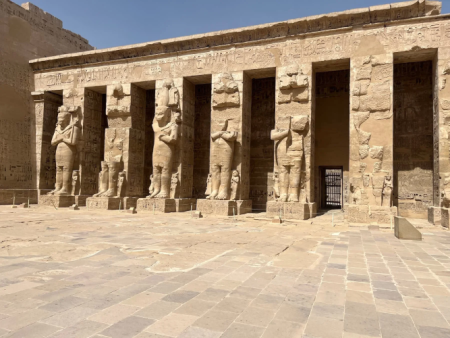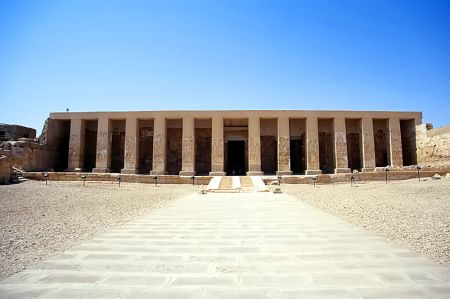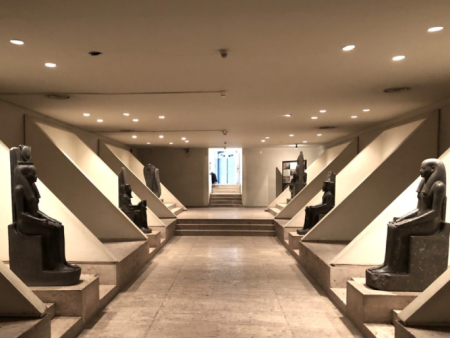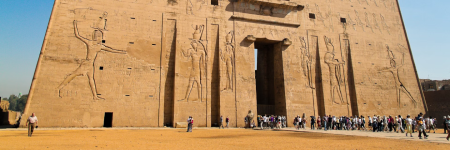Dandara Temple
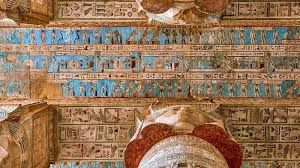
Dandara Temple – A Celestial Masterpiece of Ancient Egyptian Architecture
Hidden on the west bank of the Nile near Qena, the Dandara Temple complex stands as a breathtaking testament to the grandeur and spiritual devotion of ancient Egypt. Dedicated primarily to the goddess Hathor—the deity of love, music, beauty, and joy—this temple complex is one of the most well-preserved sanctuaries in Egypt. The Dandara Temple, sometimes called the Temple of Hathor, showcases artistic mastery and astronomical precision that continue to astonish historians and travelers alike.
The moment you enter Dandara, you’re struck by the harmony of its design and the vividness of its colorful reliefs. The roof still bears the traces of ancient pigments, offering a rare glimpse into how vibrant Egyptian temples once were. Travelers exploring this gem often include it in their itineraries alongside monumental sites like Luxor Temple or the mighty Great Pyramids of Giza. But unlike those bustling landmarks, Dandara offers something different—serenity, mystery, and the sense of stepping into a timeless celestial sanctuary.
The Dandara Temple complex isn’t merely about beauty; it embodies the Egyptian worldview, linking heaven, earth, and the divine feminine. Its astronomical alignments and zodiac ceilings reveal that ancient priests mastered both science and spirituality. For those passionate about history or simply captivated by ancient artistry, Dandara Temple is a destination that fuels awe and wonder.
Historical Origins of Dandara Temple
The origins of Dandara Temple reach deep into the prehistoric eras of Egypt. Evidence suggests that structures existed on this site as early as the Old Kingdom, though the current temple was largely constructed during the Ptolemaic period—around 125 BCE—under the reign of Cleopatra VII and her predecessors. Its completion continued into the Roman era, blending Greek architectural influence with pure Egyptian spiritual essence.
The Dandara complex was built over earlier shrines devoted to Hathor, one of the most beloved goddesses of ancient Egypt. Hathor was not only the goddess of love and motherhood but also a celestial figure linked to the Milky Way, often depicted as a cow nurturing the sun god. This temple celebrated her role as the universal mother, protector of women, and patroness of music and dance—elements that filled Egyptian daily life with joy and purpose.
As centuries passed, Dandara’s relevance never faded. Even during the Roman occupation, emperors like Tiberius added inscriptions praising Hathor and aligning Roman divinities with Egyptian theology. Modern travelers visiting Egypt through Egypt Travel Packages often include Dandara to witness firsthand how divine femininity shaped ancient Egyptian culture.
Architectural Grandeur and Symbolic Design
Architecturally, Dandara Temple stands as a masterpiece of symmetry and artistic depth. The façade, supported by massive Hathor-headed columns, immediately commands attention. Each column features the goddess’s serene face crowned by cow ears and a sistrum—her sacred musical instrument. These features make the entrance feel like a portal into a celestial world governed by harmony and beauty.
Inside, the grand hypostyle hall is adorned with detailed depictions of pharaohs offering tribute to the gods, while ceilings display scenes of the zodiac and celestial deities. The famous Dandara Zodiac, originally housed here, is one of the earliest known portrayals of constellations, signifying Egypt’s advanced knowledge of astronomy. Though the original zodiac was moved to the Louvre, the replica onsite continues to enchant visitors with its cosmic symbolism.
Every chamber within the temple bore purpose: chapels for Osiris, birth houses for Hathor’s divine offspring, and sanctuaries symbolizing the cycle of life and rebirth. When illuminated by sunlight, the rooms create a mystical interplay between shadow and light, reinforcing the temple’s role as a bridge between heaven and earth. It’s no wonder that travelers combining their historical tours with Egypt Nile Cruises often find Dandara a spiritual highlight of their journey.
The Iconography and Inscriptions of Dandara
Dandara Temple is a visual encyclopedia of ancient Egyptian theology. The reliefs lining the walls narrate cosmic myths and rituals, representing divine births, sacred processions, and offerings to Hathor. Particularly striking are the depictions of Cleopatra VII with her son Caesarion, both shown making offerings—one of the few surviving representations of Egypt’s last pharaoh.
Hieroglyphic inscriptions throughout the temple echo hymns of adoration, detailing the music, perfumes, and rituals used in daily worship. This art form wasn’t just decorative; it carried symbolic power. The colors, shapes, and arrangements reflected spiritual harmony and cosmic order—the very essence of Ma’at, the Egyptian concept of balance and truth. Those interested in such symbolism might also explore ancient artwork preserved in the Egyptian Museum of Cairo.
Religious Significance and the Cult of Hathor
Hathor’s worship at Dandara was vital to ancient Egyptian spirituality. As the goddess of love, fertility, and music, she represented everything joyous and life-affirming. Her temple served as both a sanctuary for healing and a center for festivals celebrating renewal and cosmic harmony. During the annual feast, statues of Hathor were carried in grand processions toward the Nile, symbolizing reunification with Horus of Edfu—a divine marriage ensuring the continuation of life and prosperity.
The temple’s sacred lake, used for purification rituals, and its crypts, inscribed with magical texts, underscore the depth of devotion practiced here. Pilgrims came from across Egypt to seek blessings, healing, and fertility. Even today, visitors standing under its detailed ceilings can almost hear the echoes of ancient chants. Pairing a visit here with the majestic Temple of Philae offers a profound exploration of the divine feminine in Egyptian religion.
Dandara Temple in the Modern Era
Through millennia of sandstorms and invasions, Dandara Temple has withstood the elements remarkably well. Rediscovered and excavated in the 19th century, it quickly became an archaeological marvel. Modern preservation efforts have revealed the vibrant pigments still clinging to the ceilings, proving that ancient temples were once alive with color. Recent restoration has enhanced its accessibility, allowing travelers to explore the hypostyle hall, crypts, and rooftop chapels safely.
Today, Dandara attracts historians, travelers, and photographers alike—each drawn by its mystical charm and tangible sense of eternity. Combining a visit with nearby attractions such as Karnak Temple or Temple of Hatshepsut offers a holistic view of Egypt’s religious heritage.
Travel Tips for Visiting Dandara Temple
Traveling to Dandara is a straightforward yet unforgettable experience. The temple lies about 60 kilometers north of Luxor, easily accessible by road or private tour. Most travelers prefer guided excursions that combine Dandara with the Temple of Horus at Edfu for a full day of discovery along the Nile. Visiting early morning or late afternoon helps avoid harsh sunlight and offers optimal conditions for photography.
For the best experience, wear comfortable clothing, carry water, and bring a flashlight to explore the temple’s crypts—some still hidden in shadow. Hiring a knowledgeable guide enhances the visit immensely, helping you decode the ancient symbology and architectural brilliance within every chamber. Choosing a reputable local operator specializing in Egypt Luxury Tours ensures a seamless and insightful journey.
Why Dandara Temple Should Be on Every Egypt Itinerary
Dandara Temple offers far more than aesthetic pleasure—it provides a window into Egypt’s spiritual intellect. Unlike other temples primarily dedicated to gods of war or kingship, Dandara celebrates love, music, and cosmic harmony. Its ceilings, rich with astronomical meanings, reveal how Egyptians saw their lives intertwined with celestial movements. Visitors often describe it as a temple that “feels alive.”
For travelers crafting their perfect journey through Egypt Vacation Packages, Dandara is a must-see inclusion. Whether you’re an art enthusiast, historian, or simply a curious soul, walking through its halls transports you back to a civilization where divinity and artistry walked hand in hand.
Frequently Asked Questions About Dandara Temple
1. Where is Dandara Temple located?
Dandara Temple is located near Qena, about 60 kilometers north of Luxor on the west bank of the Nile River. It’s easily accessible via organized tours or private vehicles from Luxor City.
2. Which goddess is Dandara Temple dedicated to?
The temple is dedicated to Hathor, the Egyptian goddess of love, beauty, fertility, and music. She was one of the most revered deities in ancient Egyptian mythology, often symbolizing maternal care and cosmic harmony.
3. What makes Dandara Temple unique compared to other temples?
Dandara Temple stands out for its well-preserved colors, detailed astronomical ceilings, and unique depiction of Cleopatra VII and her son Caesarion. It’s also one of the few temples where visitors can explore crypts and rooftop chapels.
4. Can visitors explore all sections of the temple complex?
Yes, visitors can access most parts of the temple, including the hypostyle hall, chapels, and rooftop sanctuaries. Some underground crypts are partially restricted to protect the carvings but remain visible for guided tours.
5. What’s the best time to visit Dandara Temple?
The best time to visit Dandara Temple is between October and April, when the weather is cooler and more comfortable for exploration. Early morning visits offer beautiful lighting and fewer crowds, making it ideal for photography and reflection.






